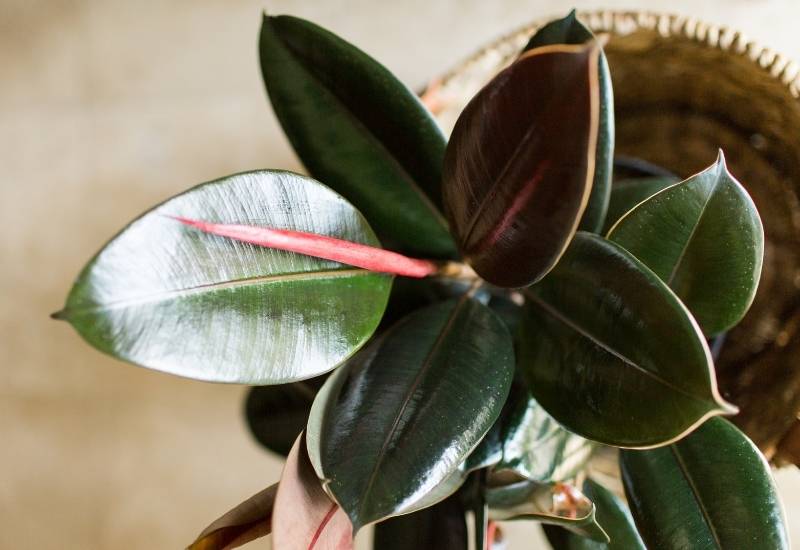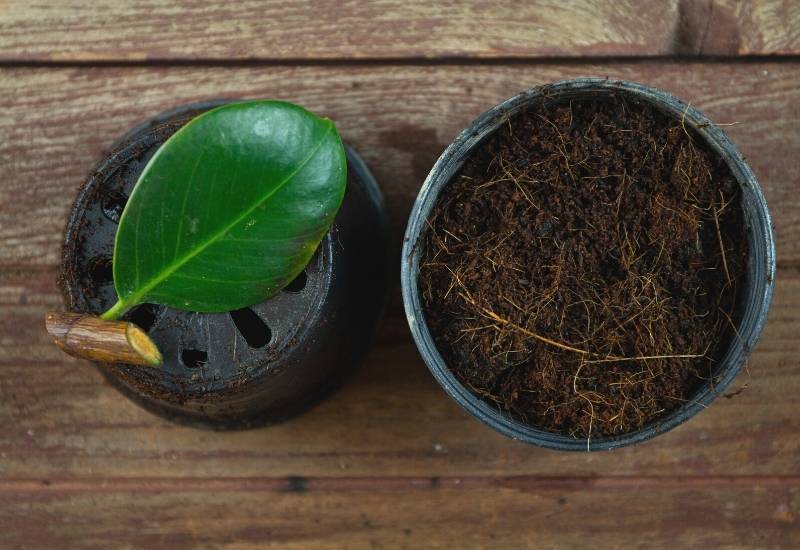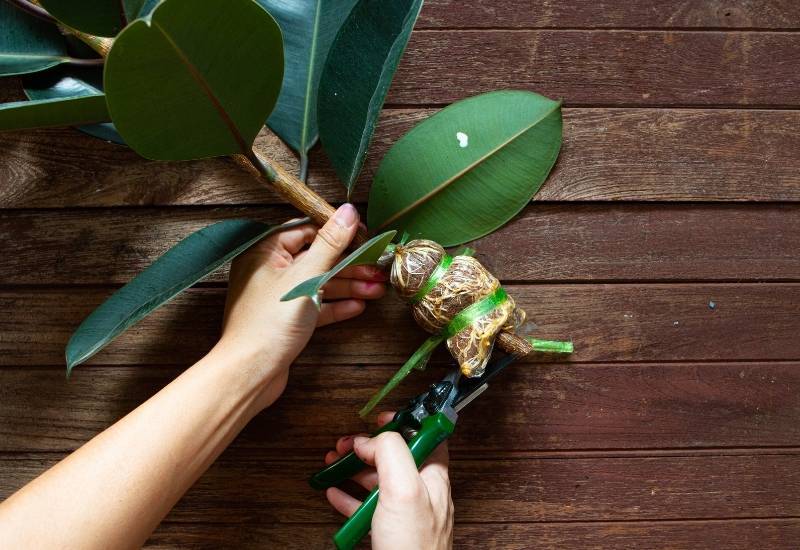With their glossy, dark green leaves, these plants can be enjoyed as a medium-sized houseplant, or grow large enough to be the focus of a room. They can grow impressive amounts in just a few years, especially if taken out during the summer months.
To make a rubber plant more bushy, pruning is necessary. To prune a rubber plant:
Rubber plants respond very well to pruning, especially if it is done around late spring or early summer. They can thrive either as a tall tree, or maintained as a bushy shrub.
Pruning a rubber plant helps keep it in good health, while encouraging a desired shape and size.
Rubber plant overview

Rubber plants are native to Southeast Asia, where they can grow up to 100 feet tall in their natural habitat. As a domesticated potted plant, they are loved for their unique leaves and low maintenance properties.
The name rubber plant actually comes from their milky white sap, which is sometimes used to make natural rubber.
You will see this sap bleed from the cuts and plucked leaves during pruning. Be careful, as this sap can cause skin irritation and blemishes.
Fortunately, rubber plants are very malleable and easy to shape to your liking. Although the classic rubber plant with its waxy, dark green leaves is most common, there are a variety of other colors as well.
Keeping your rubber plant in a small pot is an easy way to limit its growth as a smaller pot plant.
Pruning is also very important for rubber plants, as they tend to become quite tall and accessible quite quickly. If left unchecked, they can even snap under the weight of their own branches.
They can handle a fairly aggressive pruning compared to most other plants. After a major trimming, it may look a bit odd and worn out, but do not worry, it will quickly fill the space with new leaves.
Before you prune your
Rubber plants can take the form of a tall, narrow tree or a more compact, bushy shrub. Maintaining a rubber plant like a bushy shrub requires a little more planning and attention.
When to prune a rubber plant?
Although rubber plants are considered durable enough to withstand some pruning at any time of the year, it is encouraged to wait until the early growing season (late spring or early summer) for a quick recovery.
If you have to prune in the fall or winter, limit yourself to just making a few smaller cuts.
Since these plants can handle a tough prune, the final shape is up to you. With its soft, flexible branches and resilient ways, it is possible to get creative and do something unique.
However, if you want to make more dramatic changes, it is recommended that you prune in a few steps over the course of a couple of months. This will ensure that you avoid shocking the plant.
Pruning a rubber plant to promote shrubbery

Step 1: Make a plan.
Take a step back and observe your rubber plant. Decide what you want it to look like given its location and existing growth.
For example, if your rubber plant stands on a table or shelf without much room to grow, it would probably be best kept as a short, round shrub.
Pruning side branches will stimulate new growth to fill in the middle section of the plant, so choose a size that you can trim down to and then let it fill itself.
Step 2: Remove any branches that appear out of place.
Start by cutting back any of the lower branches that appear to grow straight out horizontally, or any that are interfering with your desired shape of the plant.
Some branches seem to grow in strange directions, curved or much faster than others. Remove these to keep the plant looking good and presentable.
You can also remove some branches and leaves from the center of the plant to prevent it from looking too dense, but this is a matter of personal preference.
Step 3: Cut to the desired height.
Once your rubber plant has grown to the desired height, cut off the top set of leaves before the node. By cutting before the node, instead of after, you basically leave a small stump behind you. This will prevent the plant from sending out more vertical gutters.
For a more compact shrub-like rubber plant, cut off the top when it reaches a maximum of about four feet high. This will encourage the plant to grow more horizontally and produce a more rounded shape, rather than growing tall and lean.
Step 4: Encourage leaf cover by pruning frequently.
As mentioned above, maintaining a rubber plant like a bushy shrub requires a little more maintenance than its other form as a taller tree-like potted plant. To achieve a bushy rubber plant, constant pruning is required.
When an incision is made after the node, one and sometimes two new branches will begin to develop from the place where the incision was made. When the plant has had a chance to recover from the last pruning and sent out some new gutters, cut back these as well.
Continuously pruning the new side plant gives you control over how thick and bushy the plant becomes.
Step 5: Propagate new cuttings back into the pot.
Conveniently, it is quite easy to propagate the cuttings from a rubber plant. By planting these cuttings back in the pot on your rubber plant, you can get a more bush-like appearance by helping to fill in the lower parts of the plant.
After branches have been cut during pruning, these can be immediately transplanted back into the same pot as the original plant, or first rooted in a glass of water.
Quick guide to propagating cuttings of rubber plants

The easiest way to propagate rubber plant cuttings is to take a small branch from a healthy, mature plant and let it root in water or soil. The main rule when choosing a cutting is to make sure that it has a node for new growth to grow out of.
Ideally, your cut will be about six to eight inches long with more than one node on it. Because rubber plants reproduce quite well, you can often simply plant a cutting directly back into the pot of the plant from which it was taken.
Make sure to keep the soil moist, then you have about a 50/50 chance of succeeding with this method. A useful trick to increase the likelihood that your cuttings will multiply in this way is to dip the cut end in a root hormone before planting.
If you prefer higher odds, you can choose to let your cutting root in a cup of water first. Rooting in a cup of water and transplanting to soil with a healthy established root system ensures the success of your cutting in their new home.
Make sure good Care after pruning To promote Rapid Recovery
Pruning can be a very stressful process for plants. When pruning a plant, it is extremely important to ensure that the correct care requirements are met afterwards. This will make it easier for the plant to recover and thrive.
When it comes to general care, rubber plants are fairly easy to maintain. The key to a healthy and thriving rubber plant is a well-balanced amount of sunlight and water.
If your rubber plant is not satisfied, it will begin to drop its lower leaves as a signal that one of these two resources is missing.
Rubber plants prefer to be placed in a place where they receive strong, indirect light that is not too hot.
The ideal place for a rubber plant in front of a window facing south with a curtain. This gives the plant a lot of light, without the intense heat from direct sunlight.
Rubber plants do not tolerate sitting in water, so well-draining soil is important. The frequency of watering required for a rubber plant will vary depending on the seasons.
During the summer months during the growing season, try to keep the soil moist but not supersaturated. This is especially important after pruning.
As these plants are not heavy feeders, extra fertilizer will not be of any benefit. Feeding with 1/2 strength diluted fertilizer about once a month is all they need to thrive.
Conclusion
Rubber plants are a rewarding, fast-growing and relatively little maintenance plant to have in your home. Their malleable branches and tolerance to tampering make it a highly adaptable potted plant, which can fit well into any interior.
If they are allowed the freedom and support to grow high, they will quickly exceed your expectations as a tree-like houseplant indoors. But with their delicious dark green foliage, they are just as beautiful if kept smaller than a bushy shrub.
Although it takes a little more planning and maintenance to keep a rubber plant like a small shrub, the satisfaction of tailoring a plant to fit your specific needs will make it worth the extra effort.
 pyomn
pyomn



